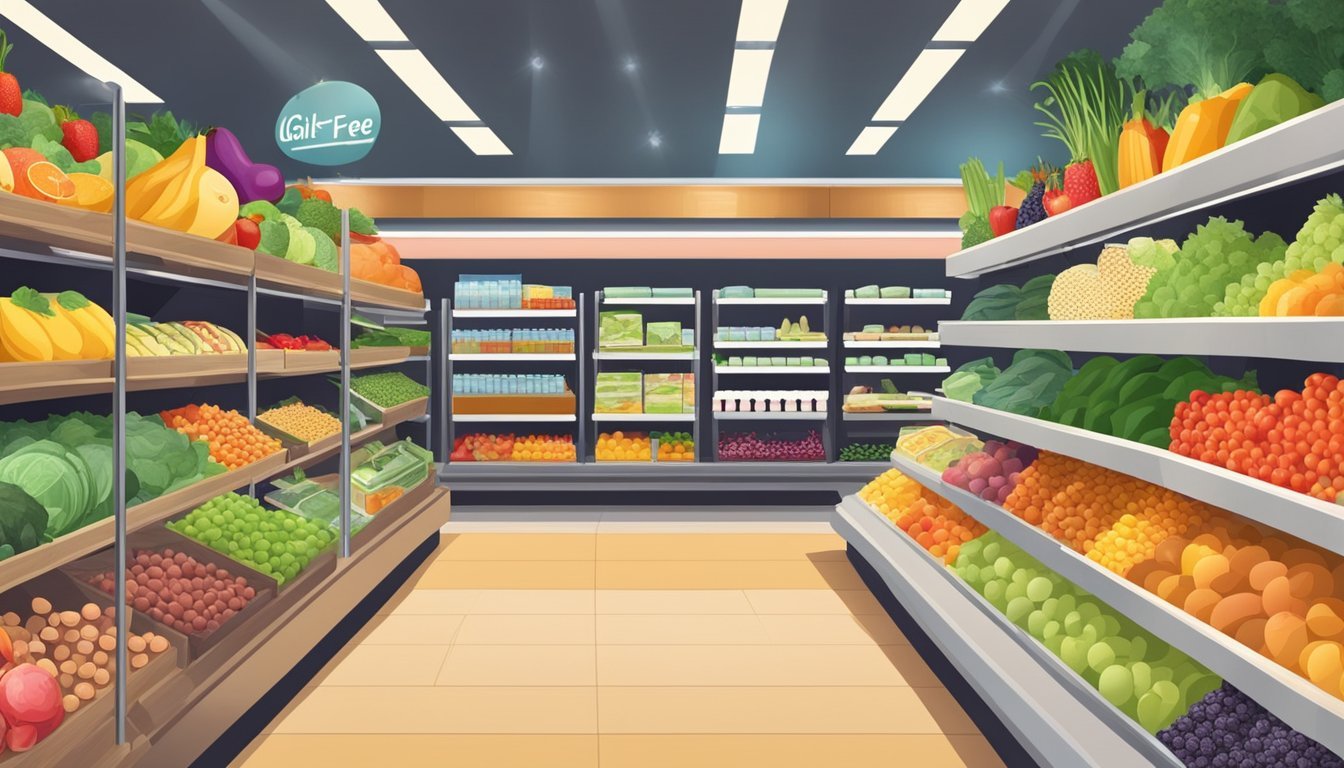Navigating Low FODMAP Shopping: Top Grocery Stores for IBS-Friendly Foods
Finding a grocery store that caters to low FODMAP needs can be a game-changer for individuals managing irritable bowel syndrome (IBS) or following a FODMAP-restricted diet. The best grocery stores for low FODMAP shopping are those with dedicated sections for specialty diets, a wide variety of fresh produce, and knowledgeable staff who can assist with product selection.
Many major supermarket chains now offer extensive options for FODMAP-friendly foods. These stores typically stock a range of gluten-free products, lactose-free dairy alternatives, and clearly labeled low FODMAP items. Some even provide downloadable shopping lists or in-store guides to help customers navigate their FODMAP-friendly offerings.
When choosing a grocery store for low FODMAP shopping, it's important to consider the availability of fresh fruits and vegetables that are safe for consumption on the diet. Stores with a diverse produce section featuring items like blueberries, strawberries, carrots, and bell peppers are ideal. Additionally, a well-stocked frozen food section can be beneficial, as many frozen fruits and vegetables are FODMAP-friendly and convenient for meal preparation.
Understanding FODMAPs
FODMAPs are specific types of carbohydrates that can trigger digestive issues in some people. These compounds play a significant role in gut health and symptom management for those with irritable bowel syndrome (IBS).
The Role of Diet in IBS
IBS affects millions worldwide, causing abdominal pain, bloating, and altered bowel habits. Diet is a key factor in managing symptoms. Many IBS patients find relief by reducing their intake of FODMAPs.
FODMAPs can be poorly absorbed in the small intestine, leading to fermentation in the large intestine. This process can cause gas, bloating, and changes in bowel movements. By identifying and limiting problematic foods, individuals can often alleviate their symptoms.
A low-FODMAP diet involves temporarily eliminating high-FODMAP foods, then systematically reintroducing them to determine personal triggers. This approach helps tailor dietary recommendations to each person's unique needs.
Origins and Research Behind FODMAPs
The FODMAP concept was developed by researchers at Monash University in Australia. Their groundbreaking work identified specific carbohydrates that contribute to IBS symptoms.
Monash University continues to lead FODMAP research, testing foods and updating guidelines. Their smartphone app provides up-to-date information on FODMAP content in various foods.
Clinical studies have shown the effectiveness of a low-FODMAP diet in reducing IBS symptoms. Research indicates that up to 75% of IBS patients may benefit from this dietary approach.
The FODMAP diet is not a long-term restrictive diet. Its goal is to identify trigger foods and establish a balanced, sustainable eating plan that promotes gut health while minimizing symptoms.
Essential Low FODMAP Grocery Items
Shopping for low FODMAP foods requires careful selection of ingredients and products. The following categories highlight key items to include in your grocery list for a well-rounded low FODMAP diet.
Dairy and Alternatives
Lactose-free milk and yogurt are essential dairy alternatives for those following a low FODMAP diet. Hard cheeses like cheddar, parmesan, and Swiss are naturally low in lactose and safe to consume. Butter is generally low FODMAP in small amounts.
Plant-based milk alternatives such as almond milk, rice milk, and hemp milk are suitable options. When selecting non-dairy yogurts, look for those made from coconut or almond.
For spreads, consider lactose-free cream cheese or butter alternatives made from vegetable oils.
Meats and Plant-Based Proteins
Lean meats like chicken, turkey, and beef are excellent low FODMAP protein sources. Fish and seafood, including salmon, tuna, and shrimp, are also safe options.
Eggs are versatile and low FODMAP. Tofu and tempeh serve as suitable plant-based protein alternatives.
Canned tuna or salmon can be convenient for quick meals. When selecting deli meats, avoid those with added garlic or onion.
Look for plain, unseasoned meats to avoid potential high FODMAP additives.
Fruits and Vegetables
Low FODMAP fruits include strawberries, blueberries, oranges, and pineapple. Cantaloupe and honeydew melon are also safe in moderate portions.
Vegetables like carrots, bell peppers, cucumber, and zucchini are low FODMAP options. Leafy greens such as spinach, kale, and lettuce are generally safe.
Frozen vegetables without added sauces are convenient choices. Canned vegetables can be suitable, but check for added onion or garlic.
Be cautious with portion sizes of some fruits and vegetables, as larger amounts may become high FODMAP.
Grains and Cereals
Gluten-free oats, quinoa, and rice are excellent low FODMAP grain options. Gluten-free bread and pasta made from rice, corn, or quinoa flour are suitable alternatives to wheat-based products.
Corn-based cereals and rice cakes can serve as quick snacks. When selecting crackers, look for those made with low FODMAP flours like rice or corn.
Polenta and buckwheat are versatile grains that can be used in various dishes. Be cautious with processed grain products, as they may contain high FODMAP additives.
For baking, almond flour and coconut flour are low FODMAP alternatives to wheat flour.
Reading Labels and Identifying Low FODMAP Options
Navigating the grocery store aisles for low FODMAP foods requires a keen eye and understanding of product labels. Proper label reading skills are essential for identifying suitable options and avoiding triggers.
Certification Labels
Look for certified low FODMAP labels on products. These labels indicate the item has been tested and approved by reputable organizations. FODMAP Friendly and Monash University offer certification programs.
Certified products undergo rigorous testing to ensure they meet low FODMAP criteria. This certification provides confidence in food choices during the elimination phase. Many brands now seek certification to cater to FODMAP-conscious consumers.
While certification is helpful, it's not the only indicator. Some low FODMAP foods may not carry certification labels but can still be suitable options.
Key Ingredients to Watch Out For
Scrutinize ingredient lists carefully. Certain components are high in FODMAPs and should be avoided during the elimination phase:
Sweeteners: honey, high fructose corn syrup, agave
Sugar alcohols: sorbitol, mannitol, xylitol, isomalt, maltitol
Wheat, rye, barley
Onions, garlic
Dairy products (in large amounts)
Be aware that ingredients like inulin, chicory root, and fructooligosaccharides are high FODMAP. These are often found in processed foods and supplements.
Understanding Serving Sizes
Serving sizes play a crucial role in FODMAP management. A food may be low FODMAP in small amounts but become high FODMAP in larger portions.
Refer to Monash University's FODMAP app for specific serving size recommendations. This tool provides up-to-date information on FODMAP content in various foods.
Pay attention to the serving size listed on product labels. Compare this to the recommended low FODMAP serving to ensure you're staying within safe limits.
Some foods, like strawberries, are low FODMAP in smaller servings but become moderate or high FODMAP in larger amounts. Understanding these thresholds helps in making informed choices.
Navigating Grocery Store Layouts
Efficient navigation of grocery store layouts is essential for low FODMAP shoppers. Understanding the typical arrangement of sections can streamline the shopping process and help locate suitable foods more quickly.
Produce Section
The produce section typically greets shoppers upon entering the store. For low FODMAP diets, focus on safe fruits and vegetables. Opt for berries, citrus fruits, and grapes. Choose low FODMAP vegetables like carrots, bell peppers, and zucchini.
Use a grocery shopping app or list to stay on track. Some stores offer organic options, which may be preferable for certain produce items. Be cautious with pre-cut fruits, as they might contain high FODMAP preservatives.
Deli and Fresh Meat
The deli and fresh meat sections usually offer plain, unprocessed options suitable for low FODMAP diets. Select plain meats without marinades or seasoning blends, which often contain high FODMAP ingredients.
Ask deli staff about ingredient lists for prepared items. Choose fresh cuts of beef, chicken, pork, or fish. These proteins are naturally low in FODMAPs and provide versatile meal options.
Packaged Goods and Labels
Navigating packaged goods requires careful label reading. Look for "low FODMAP" certifications on products. Pay attention to ingredient lists, avoiding items with high FODMAP components like honey, wheat, or onion powder.
Some brands offer dedicated low FODMAP product lines. Familiarize yourself with these options to simplify shopping. Be cautious with gluten-free products, as they may still contain high FODMAP ingredients.
Use a supermarket shopping app to scan barcodes and quickly identify suitable items.
Freezer Section
The freezer section can be a treasure trove for low FODMAP shoppers. Look for plain frozen vegetables without added sauces or seasonings. Frozen berries and pineapple chunks are excellent low FODMAP fruit options.
Check for frozen meal options specifically labeled as low FODMAP. Some brands now cater to this dietary need. Plain frozen meats and fish are also safe choices.
Be wary of frozen pizzas or meals with cream-based sauces, as these often contain high FODMAP ingredients. Always check labels, even on seemingly safe items.
Planning and Managing a Low FODMAP Diet
Effective planning and management are crucial for success on a low FODMAP diet. A well-organized approach helps individuals with IBS navigate dietary restrictions while ensuring proper nutrition.
Creating a Low FODMAP Shopping List
A comprehensive shopping list is essential for low FODMAP grocery trips. Focus on FODMAP-friendly fruits like blueberries, strawberries, and pineapple. Include safe vegetables such as carrots, bell peppers, and specific portions of broccoli.
Choose gluten-free grains and products without high FODMAP additives. Rice, quinoa, and certified gluten-free oats are excellent options. Select lactose-free dairy alternatives or hard cheeses.
Protein sources like plain meats, fish, eggs, and tofu are generally safe. Include nuts and seeds in moderation, such as walnuts and chia seeds.
Meal Preparation and Recipes
Meal prep simplifies adherence to the low FODMAP diet. Plan balanced meals incorporating a variety of allowed foods. Breakfast options include oatmeal with lactose-free Greek yogurt and berries.
Prepare simple stir-fries using low FODMAP vegetables and proteins. Homemade soups and salads offer flexibility and easy portion control.
Experiment with low FODMAP recipes to add variety. Many traditional dishes can be adapted by substituting high FODMAP ingredients with safe alternatives.
Batch cooking and freezing portions helps maintain diet consistency during busy periods.
Tips from Dietitians
Registered dietitians recommend gradually introducing the diet to minimize disruption. Keep a food diary to track symptoms and identify trigger foods.
Proper portion control is crucial, as some low FODMAP foods become high FODMAP in larger quantities. Use Monash University's app for accurate serving sizes.
Dietitians emphasize the importance of fiber intake. Incorporate allowed high-fiber foods like chia seeds and specific fruits to maintain digestive health.
Regular reassessment with a healthcare professional ensures nutritional adequacy. The reintroduction phase should be carefully managed to identify personal tolerances.
Budgeting and Shopping Tips
Savvy shopping strategies can help low FODMAP dieters save money while still finding nutritious options. Planning ahead and taking advantage of deals are key to staying on budget.
Seasonal Shopping
Buying produce in season offers both freshness and cost savings. Strawberries, blueberries, and raspberries are low FODMAP fruits that are often cheaper in summer. Carrots, potatoes, and zucchini tend to be more affordable in fall.
Frozen fruits and vegetables are budget-friendly year-round alternatives. Frozen blueberries, strawberries, and raspberries make great low FODMAP options. For vegetables, choose plain frozen broccoli, carrots, and bell peppers without added sauces.
Discounts and Coupons
Many grocery stores offer digital coupons through their apps or websites. Signing up for store loyalty programs can provide access to exclusive deals. Some stores send discount codes to newsletter subscribers.
Comparing prices between stores and looking for sales on staple items like rice, oats, and canned goods can lead to significant savings. Generic or store-brand products often cost less than name brands while offering similar quality.
Buying in Bulk
Purchasing larger quantities of non-perishable low FODMAP foods can reduce costs over time. Rice, quinoa, oats, and gluten-free pasta are good candidates for bulk buying. Nuts like walnuts and almonds also have long shelf lives.
Dividing bulk purchases into smaller portions and freezing them helps prevent waste. This works well for meats, which can be portioned and frozen for later use. Some low FODMAP produce like bell peppers and carrots can be chopped and frozen for future meals.
Special Considerations for Low FODMAP Shoppers
Navigating a low FODMAP diet requires careful attention to food choices and preparation. Shoppers must be mindful of serving sizes, potential FODMAP stacking, and nutritional balance.
Managing FODMAP Stacking
FODMAP stacking occurs when small amounts of FODMAPs from different foods accumulate, potentially triggering symptoms. To avoid this, shoppers should:
• Track serving sizes carefully • Use a food diary to monitor intake • Space out FODMAP-containing foods throughout the day
Low FODMAP certified products can help reduce stacking risks. These items have been tested for FODMAP content and are clearly labeled.
Consulting a dietitian is recommended for personalized guidance on managing FODMAP stacking. They can provide tailored advice on combining foods safely.
Eating Out and Social Occasions
Dining out on a low FODMAP diet presents unique challenges. Strategies for success include:
• Researching restaurant menus in advance • Calling ahead to discuss dietary needs • Choosing simple dishes with fewer ingredients • Asking for sauces and dressings on the side
For social gatherings, consider bringing a low FODMAP dish to share. This ensures at least one safe option is available.
Many restaurants now offer allergen menus or can provide ingredient lists upon request. These tools can help identify suitable meal choices.
Supplementing Nutrition on a Restricted Diet
A low FODMAP diet may limit intake of certain nutrients. To maintain gut health and overall wellbeing, consider:
• Taking a multivitamin approved by a healthcare provider • Incorporating low FODMAP sources of fiber, such as chia seeds or quinoa • Ensuring adequate protein intake from low FODMAP sources like eggs or tofu
Calcium supplementation may be necessary if dairy products are eliminated. Consult a dietitian to assess individual nutritional needs.
Probiotic supplements may support gut health, but choose varieties free from high FODMAP ingredients. Some brands offer low FODMAP certified probiotics.







